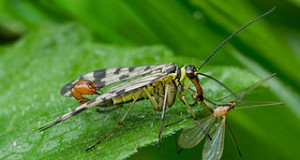While most herp enthusiasts would be thrilled with a live holiday gift, it’s important to think very carefully before you make a present of a reptile or amphibian. Difficult as it may be to believe, the recipient may not share your enthusiasm! Presenting a pet to someone who is unwilling or unable to provide proper care is unfair to both the person and the creature. This is especially true of children…you must speak with their parents beforehand, and explain all that is involved in caring for your intended gift. With these cautions in mind, let’s look at some reptiles and amphibians that are well suited for mature children and adults new to herp-keeping.
Please see the articles linked under Further Reading for detailed care information, and be sure to post any questions you may have below.
 Corn Snake, Pantherophis guttata
Corn Snake, Pantherophis guttata
The Corn Snake is one of North America’s most beautifully-patterned reptiles, and the world’s most popular serpent pet. Despite having crossed paths with hundreds of species during my career as a herpetologist, I reserve a special fondness for these undemanding beauties. Topping out at a manageable 2.5 to 4 feet in length, Corn Snakes are amenable to gentle handling and can be housed in a 20-55 gallon aquarium. A hide box, incandescent heat bulb, water bowl, and a pre-killed mouse (available, frozen, at pet stores) each 7-10 days completes their needs. Longevities in excess of 20 years are known, and captive breeding – which has resulted in over 25 unique color phases – is commonplace.
Japanese and Chinese Fire-Bellied Newts, Cynops pyrrhogaster and C. orientalis
Fire-Bellied Newts have much to recommend them as pets. They are active by day and quickly lose any shyness about exhibiting a range of interesting behaviors. Average room temperatures suit them well, and a pair can be kept in a 5 gallon aquarium equipped with a simple filter. Reptomin and other commercial foods, with occasional feedings of live blackworms (sold as tropical fish food), can serve as the basis of their diet. Fire-Bellies often surprise their owners with eggs, offering an excellent introduction to amphibian breeding. Note: all newts produce skin toxins that can be harmful, and for certain species fatal, if swallowed; children must be supervised.
Leopard Gecko, Eublepharis macularius
There’s good reason why this attractive little lizard is one of the world’s most desirable reptilian pets. Unlike Bearded Dragons and other popular lizards, the Leopard Gecko does not require access to UVB radiation. This simplifies care and reduces expenses. They are also slow-moving, calm in demeanor, and very amenable to handling…a big plus for children. Their dietary and space needs are quite modest, and a wide variety of inexpensive heat sources and other gecko-specific products are available. Although typically active by night, pets are always willing to eat during the day, and their nocturnal wanderings can be viewed with the aid of a red/black night bulb.
Common Musk Turtle, Sternotherus odoratus and its Relatives
I always hesitate to recommend turtles as first-time pets. Most need a great deal of room, expensive life support equipment, and their care can be quite time consuming. One possible exception is the Common Musk Turtle and such relatives as the North American Mud Turtle. While not exactly “simple” to care for, they make excellent choices for someone set on turtle ownership. Maxing out at 5 inches or so, the Musk Turtle can be accommodated in a 20 gallon aquarium equipped with an easy-to-clean filter. It differs from most turtles in not requiring UVB exposure, and a fish tank heater will meet its modest temperature requirements. A diet of high quality turtle pellets, supplemented with minnows, earthworms and other easily-obtainable foods, will keep them in great health long-term – as attested to by the 45 year-old female that is watching me as I type!
African Clawed Frog, Xenopus laevis
Several African Clawed Frogs in my collection have lived into their mid-20’s, and all have been most amusing. Bold and brassy, these aquatic frogs quickly learn to “beg” for food, and readily feed from the hand. They do fine at temperatures ranging from 55-90 F, and, unlike almost all other frogs, accept non-living foods such as reptile and fish pellets (occasional insects are also appreciated). A simple filter and weekly partial water changes are essential to their health…provided that, African Clawed Frogs will prove to be among the hardiest of all amphibian pets.
Further Reading
Keeping Corn Snakes and other Ratsnakes
 That Reptile Blog – Reptile, Amphibian and Exotic Pet Care and Information
That Reptile Blog – Reptile, Amphibian and Exotic Pet Care and Information








I think your paragraph about fire-bellied newts needs a little more information: definitely a warning about pet shop newts – they are not healthy animals and instead of rewarding their new owner with interesting behaviours, they are likely to cause trouble and heartache. Buying pet shop newts should be discouraged. Another thing worth mentioning is that you must not add newts to a fish tank, they need their own aquarium.
I would generally discourage anyone from giving animals as gift unless it is parents who understand what they are getting into. People should always gather as much information as possible before obtaining a pet and have a suitable enclosure or tank ready, which for an aquatic animal also means well cycled.
Hello,
Thanks for your interest.
Pet stores vary widely in their dependability, degree of expertise, health of the stock etc, so of course one must choose carefully. Captive bred individuals of this species are, however, becoming more common in the trade…animals from reputable stores can make fine, very long-lived pets if given proper care.
Specifics re care are in the articles linked under further reading…this article is an introduction only.
Best regards, Frank